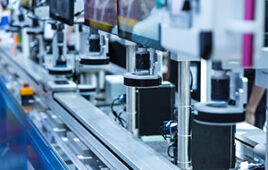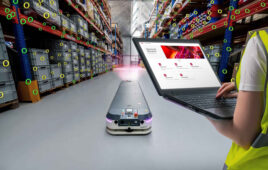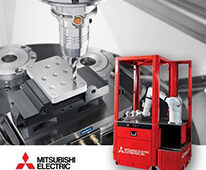By John Gyorki, Editorial Director
David J. McFate
Field Applications Engineer
IOtech, Inc.
Cleveland, OH
Data acquisition systems come in three different types: laboratory, distributed, and portable. Laboratory and distributed systems are typically stationary, permanently placed systems composed of relatively large or bulky hardware and connect to desk-top computers in one way or another. These systems depend on the computer to access, process, and analyze input data and prepare it for presentation. Portable systems, in contrast, are small, lightweight boxes that are easily hand carried and work with laptop computers or no computer at allwhen installed at a site to record data only.
Laboratory and distributed systems usually conform to an industry packaging standard. Some laboratory systems mount in standard 19-in. racks while distributed systems use track mountings. A subset of these systems includes a host computer that accommodates data acquisition plug-in boards. Portable systems, on the other hand, have no similar standard form factor to follow and can take on various sizes and shapes, although they are normally light and small. In addition, portable systems are further classified as either stand-alone units or those that connect to a personal computer. Stand-alone units are self-contained data loggers and don’t require a PC connection to function.

Some “stand-alone” data acquisition systems are extremely compact, come in modular form, and can measure voltages and thermocouples on every analog channel. The Personal Daq/3000, for example has a 16-bit, 1.0 MHz A/D, 16 inputs and counter.
Most modern data acquisition systems, regardless of form factor, accomplish their intended tasks extremely well, that is, they acquire and process the data. All systems have several factors in common; they need signal conditioners to convert sensor signals and other electrical inputs to a form that a processor can handle. They also have a wide variety of analog input channels numbering from two to several hundred, and in some cases, thousands. Moreover, inputs may be isolated or not, and either single-ended or differential, or both. Of the three types, portable systems are gaining a larger market share as the other systems age, and these portable systems are increasingly outperforming them. In addition, the new portable systems can be easily configured for laboratories and distributed systems as well as portable applications. But when considering a data acquisition system to purchase, the critical functional parameters that differentiate them include accuracy, resolution, and sampling rate.
Accuracy versus Resolution
Instrument manufacturers usually supply specifications that define accuracy and resolution. Unfortunately, not all of these specifications are uniform from one manufacturer to another, or expressed in the same terms. Some specifications are given as worst-case values, while others take into consideration actual measurements.
Accuracy can be defined as the amount of uncertainty between the measured value and a standard. Accuracy contains errors due to offset and gain parameters. Offset is usually a fixed value independent of the magnitude of the measured variable. In contrast, gain errors depend on the magnitude and are expressed as a percent of reading.
Resolution is primarily a function of the A/D’s bit depth. A 16-bit A/D has a resolution of 1 part in 65,536 and a 24-bit A/D has a resolution of 1 part in 16,777,216. This means that the smallest theoretical voltage that can be resolved with a 10-V input signal is 153 microvolts and the 24-bit yields about 1.0 microvolt. But noise plays a significant role in the resolution and can make a 24-bit A/D take an equivalent 20-bit A/D reading. Taking an average of multiple readings can reduce the effect of noise, but it sacrifices acquisition speed.
High-Speed Data Acquisition
An ideal data acquisition system automatically and simultaneously sets input amplifiers for channel gain and bipolar or unipolar operation, digitizes the signal, calibrates the reading, and sends it to the PC via a FIFO buffer or optional internal memory. However, this arrangement would require that a precision 16 to 24-bit A/D converter be used in each channel. And this is the ultimate arrangement, of course, principally because all channels are sampled simultaneously. However, a more practical and economical approach uses a multiplexer at the input to sample each channel, one at a time in sequence, and switch it’s output signal to a master A/D converter. This approach uses high-speed switching and assumes that the input signals are changing relatively slowly with regard to one another, so that the presented data appears to be captured simultaneously.

One version of a 16-bit data acquisition board intended for OEM and embedded applications uses a USB port to interface with the host computer.
To accomplish this, the sequencer is first set up to measure any combination of channels in any order and associated ranges within a group. Next, the multiplexer/sequencer waits for a trigger signal to begin scanning and digitizing. When scanning begins, the system selects the appropriate channel and gain, digitizes the input signal, calibrates the reading and sends it to the PC in the same manner described earlier. This process repeats at a specific sample rate until all channels within a scan group are completed. Moreover, many systems can operate with different scan rates, and the number of scans can be programmed to commence before and/or after a trigger with various repetition rates. The scan rate is proportional to the dynamic range of measurements that are possible to be measured and recorded. For a 1-MHz scan rate for example, each channel is given a 1-microsecond slice of time to make its measurement, then the MUX is off to the next channel. The PC generates the software trigger that causes the DAS to begin scanning the setup predefined in the scan buffer. When eight channels are scanned sequentially, the time between sampling the first channel and the eighth channel is 7 microseconds. For applications that require simultaneous sampling of all channels, you can purchase an eight-channel simultaneous sample-and-hold card or module. This is where the cost begins to escalate, and supports the rationale for multiplexing.
Obsolescence
First estimate the anticipated life of your data acquisition and test system. Consider that most systems are used at least 25% longer than originally planned. The most widely used period is three to five years, during which time you are not likely to experience obsolescence. However, if you expect eight to ten years, you may be disappointed. Recall the hardware and software platforms that were available 10 to 12 years ago. For example, personal computer buses evolved from the early IBM PC to the current PCI, which is now the most widely used. Its extension, the growing PCI-Express, first had been reserved for cards that require wider bandwidth, but now they are appearing to be used exclusivly in some new computers. In addition, the newest interface buses include USB, Ethernet, and Firewire. They have largely replaced RS-232, GPIB, and IEEE-488 in new equipment although they are still widely used. But since the technology changes so rapidly, today’s new bus could easily be obsolete tomorrow. So your system should have the capability to accommodate standard APIs, without regard to the popular bus of today.

Input Interfaces
The interface buses discussed above deal with the connection between the output side of the data acquisition system hardware and the input to the computer. The input side of the data acquisition hardware connects to the sensors. These sensors are usually located some distance from the data acquisition hardware, which includes the PC when needed. This is because the sensor environment can be too hot or cold, is chemically hazardous, or is dangerous to humans or equipment in some other way. However, some sensors such as low-level, charge-coupled accelerometers require their signal-conditioning hardware to be nearby to reduce lead length and the possibility of electromagnetic and electrostatic noise induction and signal attenuation. Although sensors such as strain gages and thermocouples have low-level output signals too, they can tolerate leads that run comparatively long distances because of their low impedance. Thus, the operating environment, each sensor type, and the various signal conditioners are among the first critical factors to consider for hardware purchases.
Data Acquisition systems are configured to measure virtually any variable. The common ones include temperature, vibration, strain, voltage, and current. The most widely used temperature sensors are thermocouples, RTDs, and semiconductor transducers. Vibration measurements encompass shock, sound, and displacement. Accelerometers measure shock and vibration and microphones measure sound. Strain gages are resistive elements arranged in full, half, or quarter-bridge circuits and produce an output signal under stress. Voltage and current are straightforward basic measurements and are recorded and scaled with their primary units of measure. Except for voltage and current measurements, most sensors require special signal conditioners.
Special Boards
Some data acquisition system manufacturers provide specialized signal conditioners for unusual or uncommon signals and special applications. Make certain that the system you purchase is flexible enough to accommodate these inputs, even if you don’t have a current need for them or even in the foreseeable future. With technology changing so rapidly, your test requirements could change overnight. These special boards might consist of extremely low-level signal conditioners, analog expansion modules, sample and hold cards, programmable low-pass filters, and isolated signal conditioning modules. Others may include counter/encoder modules, high-voltage modules, DSA with TEDS, GPS location sensing, digital I/O, optical I/O, relay modules, and frequency input cards.

An extremely versatile configuration for a “stand-alone,” portable data acquisition system has the foot print of a laptop computer and can be connected to a variety of expansion modules. This WaveBook has eight built in inputs, but can be expanded to 288 high-speed channels or 854 lower speed thermocouple channels.
Storage Media
The host PCs usually store the data captured by the data acquisition system. However, some data acquisition systems come with additional memory to supplement the PC. It samples at full speed and lets the PC handle other tasks, transparently. This is particularly helpful when the PC’s communication port or disk is too slow to keep up with the sample rate of the acquisition system. The external memory can accept the data at full speed and transfer it to the computer at a slower rate. This acquisition continues until the full capacity of the memory is reached or the test completes. The memory can also operate as a storage buffer and transfer the data to the PC at the end of the test. During the testing period, the PC is entirely free to handle other tasks.
Software Considerations
Many data acquisition systems come bundled with a dedicated software package that lets users set up, configure, and display a number of variables such as analog frequency, counter, and digital I/O channels in real time. It also configures acquisition parameters such as trigger events, stop events, and acquisition-scan rates. Moreover, it can apply the units of measure, apply the scale, and place the offset for real time mX + B equations.

Some stand-alone data acquisition systems are intended for specific applications, such as this StrainBook for strain measurements. It has eight built-in strain channels, but can be expanded to 64 channels per unit, or 256 strain channels with multiple units.
These are all necessary functions, of course, to run and interpret the data. However, the platform you purchase should not be limited to operating only with the manufacturers’ supplied software. You should expect more flexibility, such as compatibility with several vendors’ software. These could include LabVIEW and DASYLab; two widely used icon-based, acquisition, graphics, control, and analysis software packages. DASYLab supports more than 20 vendors and has a wide variety of I/O capability to choose from including analog, digital, counter/timer, IEEE 488, RS-232, and DDE. It also handles any I/O device that is supported by an OPC (OLE for process control) driver.
A number of post-acquisition software packages are also available for specialized data analysis. They should provide time domain and frequency domain analysis capability with easy-to-use graphical interfaces. Time domain and frequency domain waveform data should be viewed simultaneously.

Another portable system is intended for sound and vibration analysis and monitoring. It contains a high-speed Ethernet connection to the host computer and has 4 tachometer channels for rotating machinery. It is widely used by vibration engineers to diagnose and repair turbine power generation machinery.
Bus Architecture Lineup
GPIB: The General Purpose Interface Bus has been used for many years for controlling instruments, and it continues to survive. Many manufacturers still support drivers for it. The IEEE 488 specification defines this bus in terms of the software requirements and electrical, mechanical, and operating features. It is an 8-bit standard and can transfer data up to 8 Mbytes/s over a robust shielded cable connected to as many as 14 instruments simultaneously.
PCI: The PCI bus has been widely used for more than 10 years, and continues to survive. However, each new generation of processors and I/O devices require more bandwidth, and several attempts have been made to satisfy the demand by extending PCI’s capabilities. The relatively new PCI-Express seems to suit these requirements, and is likely to totally replace PCI. However, a more practical approach might be to see a PCI-Express socket alongside the standard PCI cards, reserved for the few cards that demand the much higher bandwidth.
Ethernet: This bus is increasingly being added to instruments as a communication interface. It has been used for some time on the factory floor and has a number of incarnations due to its complexity and flexibility. The Ethernet standard specifies the first two layers of the 7-layer OSI model, the physical and the Data Link. Theoretical standard transfer rates are 10 Mb/s, 100 Mb/s, and 1.0 Gb/s, although a real-world physical system may not fully realize these claims. Ethernet supports remote control by multiple users at different locations, and are often used with inexpensive gateways to other interfaces such as RS-232 and USB.
USB: The Universal Serial Bus is now widely used and is quickly replacing RS-232 for most applications. USB 1.0 handles data transfers from 1.5 to 12 Mb/s. The more recent USB 2.0 data transfer rate increased to 480 Mb/s, and can handle audio and video signals quite adequately. Another benefit of USB is its ability to automatically detect and configure the system for a USB-peripheral device. The instruments you buy today should claim “High-Speed USB” in order to meet the 480 Mb/s rates. USB ports also come in Type A and Type B. Type A connectors are made with a single row of pins and are intended for connecting peripheral devices such as disk drives, keyboards, and flash memory devices. Type B ports are square shaped and are intended for instrument control. In the early days, not all USB instrument protocols were guaranteed to be the same. To change this situation a user group was formed that introduced a special device class called the USB Test and Measurement Class (USBTMC), which emulates the IEEE 488.1 standard. Otherwise, a special driver is required. It would be wise to confirm that the new equipment you purchase is ready to go with one configuration or the other, so you won’t be wondering why the system doesn’t work.
Serial: The RS-232 protocol is likely the oldest standard serial interface, designed originally to handle Teletype equipment and modems. It was adapted for use with laboratory instruments and eventually a form of it was used with early computers in the 1960s. Although relatively slow, it persisted even into the 1990’s on laptop computers. Only recently has it given way to the USB, and it is now rare to find a laptop with an RS-232 port.
Firewire: The IEEE-1394 FireWire interface originated at Apple Computer in the early 1990s. It has a data transfer rate of 400 Mb/s and is currently being upgraded to run at about 3 Gb/s or more. The drawbacks of this network is the devices must be quite physically close to one
another to realize these speeds, and it is not as robust as some of the other networks for test and measurement applications.
Wireless: The biggest benefit of Wireless Ethernet (IEEE 802.11) is that it can remotely control instruments without using cables. It is slower than hardwired Ethernet and has some security issues. Bluetooth is another recently introduced wireless interface and is increasingly gaining wider acceptance.
Bridge Products: If you are currently using GPIB or Ethernet in your instrumentation and wish to go with USB instrument control, you can purchase a bridge device that converts a USB port into either a qualified GPIB or Ethernet controller. Many vendors also make devices to convert other buses, and most operate seamlessly.
Sensor Inputs
Thermocouples & RTDs: Thermocouples are extremely low-impedance devices that generate millivolt signals and require low-noise, high-gain amplifiers to make adequate use of the signals. RTDs and semiconductors have higher impedances and require different input amplifiers. Although these sensors provide a voltage output, data acquisition systems that are specified only for measuring voltage may not be suitable for measuring these device outputs. Always check with the data acquisition system provider to ensure signal conditioner-to-sensor compatibility.
Strain gages: Strain gages are virtually two-dimensional, resistive-element devices that are bonded to the specimen to be measured. Typically, from one to four sensors are arranged in a bridge circuit and balanced under no load to provide a zero voltage at the output terminals. When stresses are placed on these sensors, their elements change resistance, unbalance the bridge circuit, and produce an output voltage proportional to the stress they encounter.
Accelerometers: Accelerometers come in two basic types, integrated circuit and capacitive. The integrated circuit type requires several volts at a couple of mA to operate, and most data acquisition front ends or signal conditioners supply this power. Accelerometer signal conditioners may have an I/O connector that both provides this power for the sensor and accepts the sensor’s output signal. Accelerometer signal conditioners have several gains to accommodate a wide range of output signals measured in g/V.
Voltage: Data acquisition system input voltages usually fall into three different categories: +/-10V, microvolts, and high voltage. The most common range is from +10 to -10 V. However, special preamplifiers are needed to measure microvolts because they are easily susceptible to noise interference. These preamplifiers have a large signal-to-noise ratio, and usually come with double-ended input terminals. Double-ended inputs isolate both input terminals from ground to reduce noise pick up and ground loops. A particular shielded cable prevents electrostatic and electromagnetic signals from being coupled to the input terminals. Voltages higher than 10V require a special preamplifier and often allow signals up to 60V to be measured. Higher voltages may be measured, but they have built-in voltage dividers and are considered special.
Current: Electrical current is often measured as a voltage drop across a fixed resistor. The current value is calculated from the quotient of the measured voltage and the fixed resistor. This can be set up and scaled within the data acquisition software, an important feature that should be considered when purchasing a data acquisition system.
::Design World::
Filed Under: Factory automation, Data acquisition + DAQ modules





Tell Us What You Think!